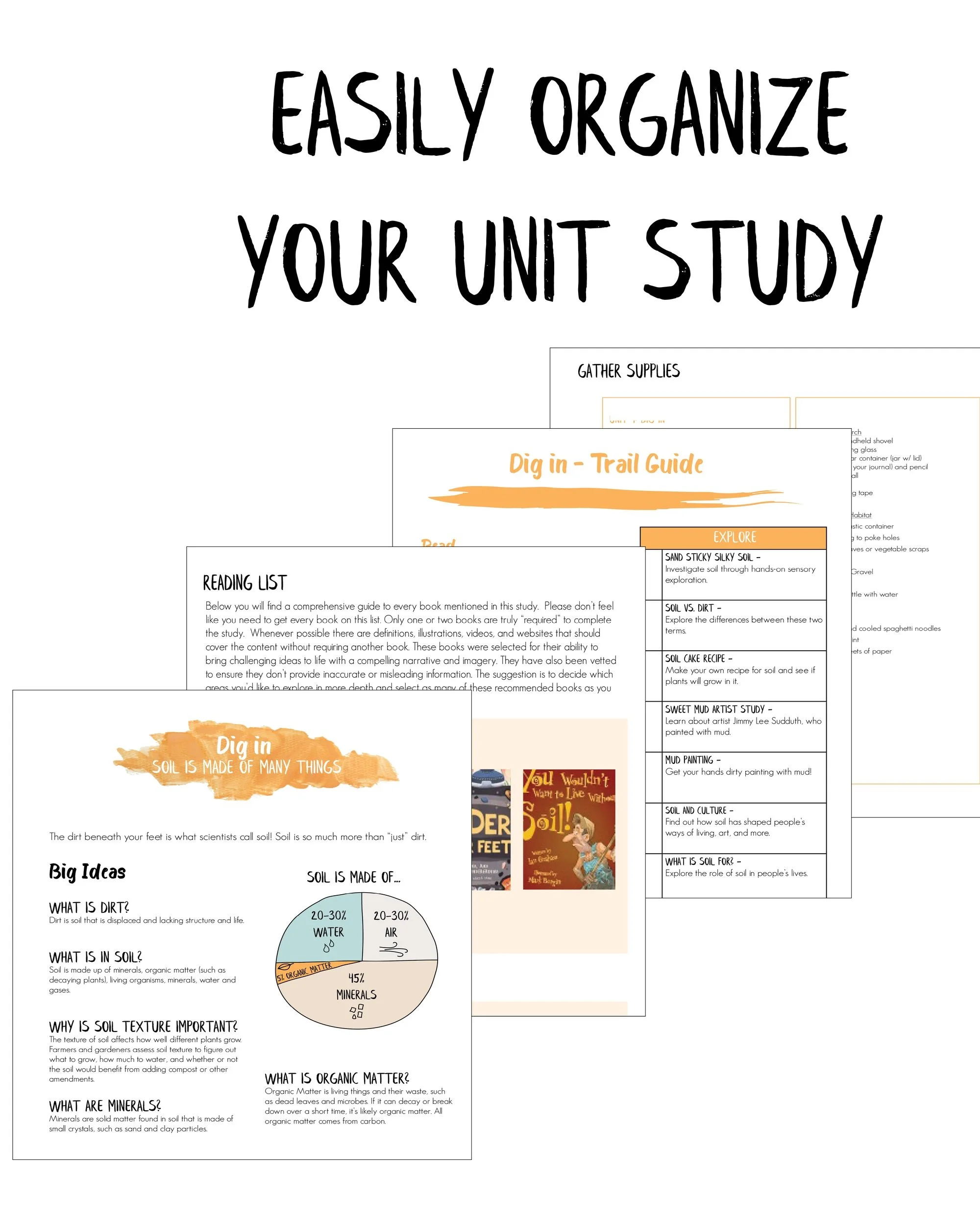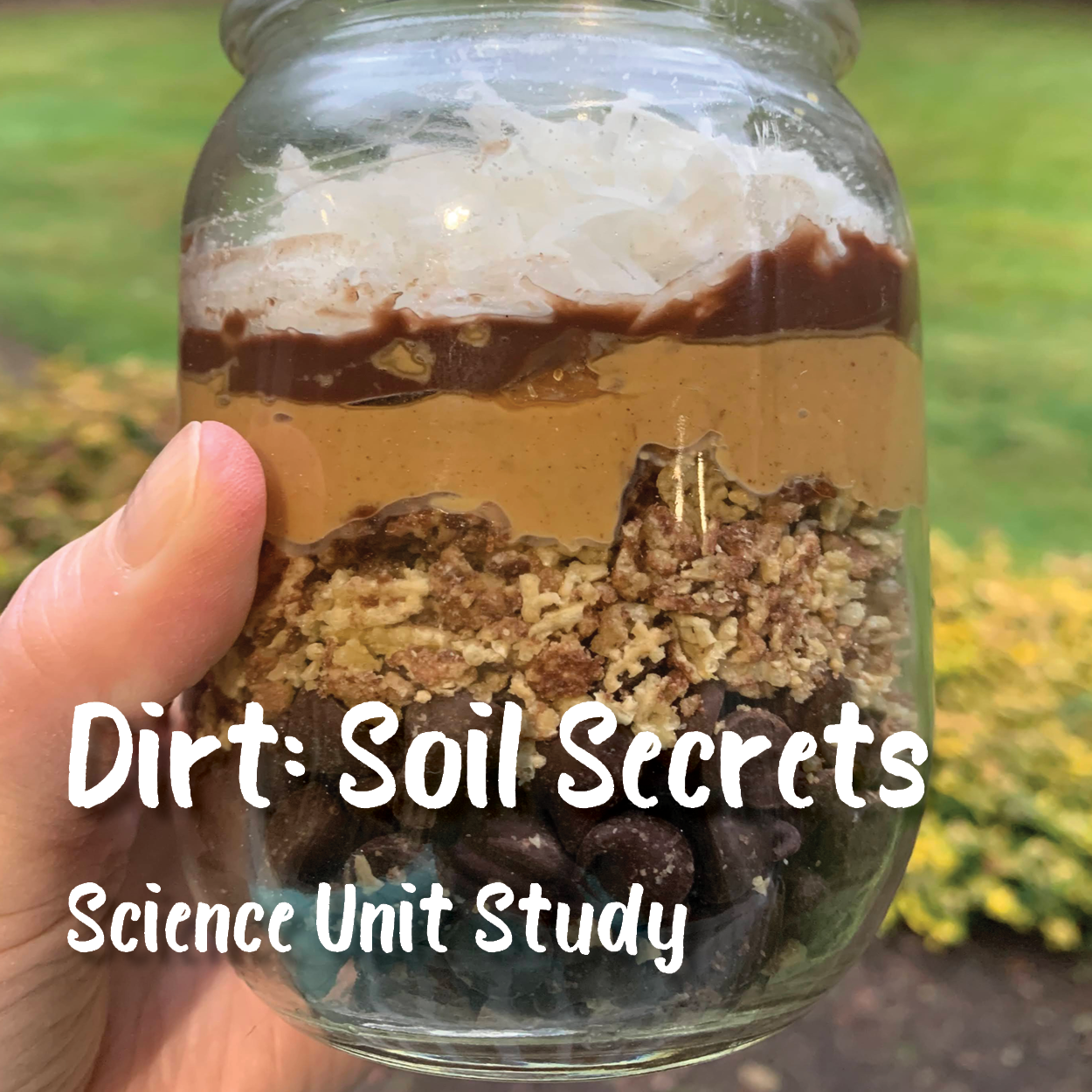In this adventure, kids will explore:
What is soil? How is soil different from dirt?
What is soil made of?
What is soil texture?
What is the role of soil in people’s lives? Why is it important?
Secular Homeschool Science Curriculum
NorthStar’s unit study guides can be combined to form a stand-alone secular science curriculum, as STEAM lesson plans, or as a homeschool unit study to bring variety and enhance the science curriculum of your choice. Dirt: Dig In was designed with homeschool families in mind, but it is equally as useful for classrooms, cooperatives, afterschool programs, and science clubs. The flexible unit study plan encourages child-led learning with inquiry and discovery at the core of the activity design. Adults will love the clearly laid out activity guides, easy-to-use graphic organization, integrated math and literacy activities, and cross-curricular extensions. Kids will love the hands-on fun STEAM activities, engaging books, visual learning and media options, and so much more!
This 27-page guide is packed full of easy fun STEAM activities for elementary kids:
4 main hands-on STEAM projects for elementary and middle school students ages 5-12 with detailed how-tos, troubleshooting, supply lists, and information about the science
Play-based math and literacy activities integrated into core projects
Big ideas prep adults with the main concepts including the importance of soil texture, organic matter and minerals
Curious questions prompt inquiry-based learning for deep science exploration and discovery
3 carefully selected living book recommendations - Excellent book selections that bring challenging ideas with a compelling narrative and imagery (books are not required to complete the study)
Kid-approved media recommendations to explain how important soil is to our environment
Social studies mini-study to provide cross-curricular connections with the topic
Engaging poetry copy work selection with teaching notes with mini-poster of poem included to encourage multi-sensory writing alternatives.
Notebooking activities and templates - kids will make a “Discovery Journal” to track and reflect on learning
Level indicators to make it easy to select activities or differentiate for the ages of your learners - from preschool through elementary with advanced topics for older learners.
NOTE: This product is a digital download. No physical copy will be sent. Sales are final. We recommend downloading within the first 24 hours. You are purchasing a document license for one household only. Please do not share or redistribute - our small business depends on your honesty!
If you are looking for printing services, we have partnered with Watson Family Press to provide our customers with discounted printing. A code will be provided to you in your download email.
The NorthStar Approach - A Learning Adventure
Engage: Great books and media recommendations help teach the big ideas.
Explore: Hands-on science explorations, process art, food fun, and more provide multi-sensory learning experiences to deepen understanding.
Express: Children are encouraged to track their observations in their Discovery Journal and to reflect on their key discoveries at the end of their studies.
Extend: Children are encouraged to take it further with resources to deepen learning about the topic and additional project ideas. Each lab includes optional cross-curricular extensions, including math and literacy activities with poetry copy work, wordplay, math fun, and story starters.
Praise for “Dirt”
“The entire unit plan is easy to follow - with sections like Big Ideas/Read/Watch. I love the simplicity of learn something, read something, watch something and then make something….It is also really flexible too as a family can do every part or skip around based on what time they have/hands on parent they have…The language in the unit is friendly - as a teacher I have found the importance of friendly and inviting language but now as a parent/homeschool parent, it instantly puts you at ease. From the opening activity of “Map Your Own Route” to “Wonderful Words” and then the connotation behind “painting, pudding, play.” Any child would want to do this. “ - L. Engstrom, homeschool mom and former teacher
“I like how it flows…and I love how you integrate art, the interactive painting and getting really into the mud, this is EXCELLENT” - J Perez, homeschool mom and artist
-
NGSSMS-LS1-5
Construct a scientific explanation based on evidence for how environmental and genetic factors influence the growth of organisms. Examples of local environmental conditions could include availability of food, light, space, and water. Examples of genetic factors could include large breed cattle and species of grass affecting growth of organisms. Examples of evidence could include drought decreasing plant growth, fertilizer increasing plant growth, different varieties of plant seeds growing at different rates in different conditions, and fish growing larger in large ponds than they do in small ponds. Assessment does not include genetic mechanisms, gene regulation, or biochemical processes.
NGSS5-PS1-3
Make observations and measurements to identify materials based on their properties. Examples of materials to be identified could include baking soda and other powders, metals, minerals, and liquids. Examples of properties could include color, hardness, reflectivity, electrical conductivity, thermal conductivity, response to magnetic forces, and solubility; density is not intended as an identifiable property. Assessment does not include density or distinguishing mass and weight.
NGSS4-LS1-1
Construct an argument that plants and animals have internal and external structures that function to support survival, growth, behavior, and reproduction. Examples of structures could include thorns, stems, roots, colored petals, heart, stomach, lung, brain, and skin. Assessment is limited to macroscopic structures within plant and animal systems.
NGSS5-PS1-4
Conduct an investigation to determine whether the mixing of two or more substances results in new substances.
NGSSK-ESS3-1
Use a model to represent the relationship between the needs of different plants or animals (including humans) and the places they live. Examples of relationships could include that deer eat buds and leaves, therefore, they usually live in forested areas; and, grasses need sunlight so they often grow in meadows. Plants, animals, and their surroundings make up a system.
NGSSMS-LS2-5
Evaluate competing design solutions for maintaining biodiversity and ecosystem services. Examples of ecosystem services could include water purification, nutrient recycling, and prevention of soil erosion. Examples of design solution constraints could include scientific, economic, and social considerations.
NGSS5-LS2-1
Develop a model to describe the movement of matter among plants, animals, decomposers, and the environment. Emphasis is on the idea that matter that is not food (air, water, decomposed materials in soil) is changed by plants into matter that is food. Examples of systems could include organisms, ecosystems, and the Earth. Assessment does not include molecular explanations.
NGSS2-ESS1-1
Use information from several sources to provide evidence that Earth events can occur quickly or slowly. Examples of events and timescales could include volcanic explosions and earthquakes, which happen quickly and erosion of rocks, which occurs slowly. Assessment does not include quantitative measurements of timescales.
NGSS2-PS1-1
Plan and conduct an investigation to describe and classify different kinds of materials by their observable properties. Observations could include color, texture, hardness, and flexibility. Patterns could include the similar properties that different materials share.
NGSSK-ESS2-2
Construct an argument supported by evidence for how plants and animals (including humans) can change the environment to meet their needs. Examples of plants and animals changing their environment could include a squirrel digs in the ground to hide its food and tree roots can break concrete.
NGSSK-LS1-1
Use observations to describe patterns of what plants and animals (including humans) need to survive. Examples of patterns could include that animals need to take in food but plants do not; the different kinds of food needed by different types of animals; the requirement of plants to have light; and, that all living things need water.
NGSS5-LS1-1
Support an argument that plants get the materials they need for growth chiefly from air and water. Emphasis is on the idea that plant matter comes mostly from air and water, not from the soil.Description text goes here
Explore All Products in the Dirt Unit Study Series
Want to learn more about soil? Check out Living Earth, the next unit in the series! Or plan a grand learning adventure with Dirt - a full 2 months (or more) of cross-curricular science fun!















